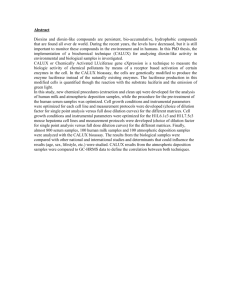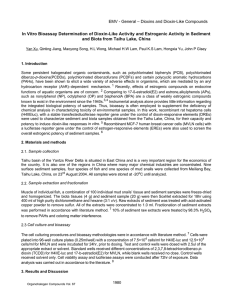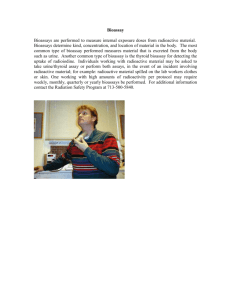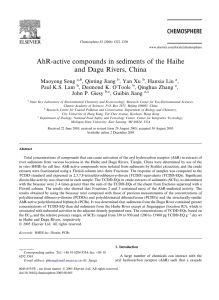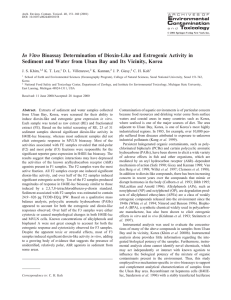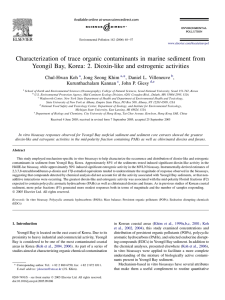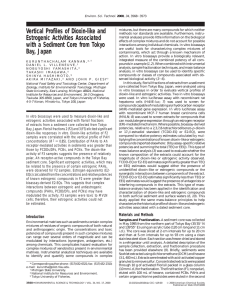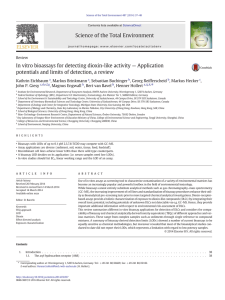Characterization of Dioxin-like Compounds in Environmental Samples from In Vitro
advertisement
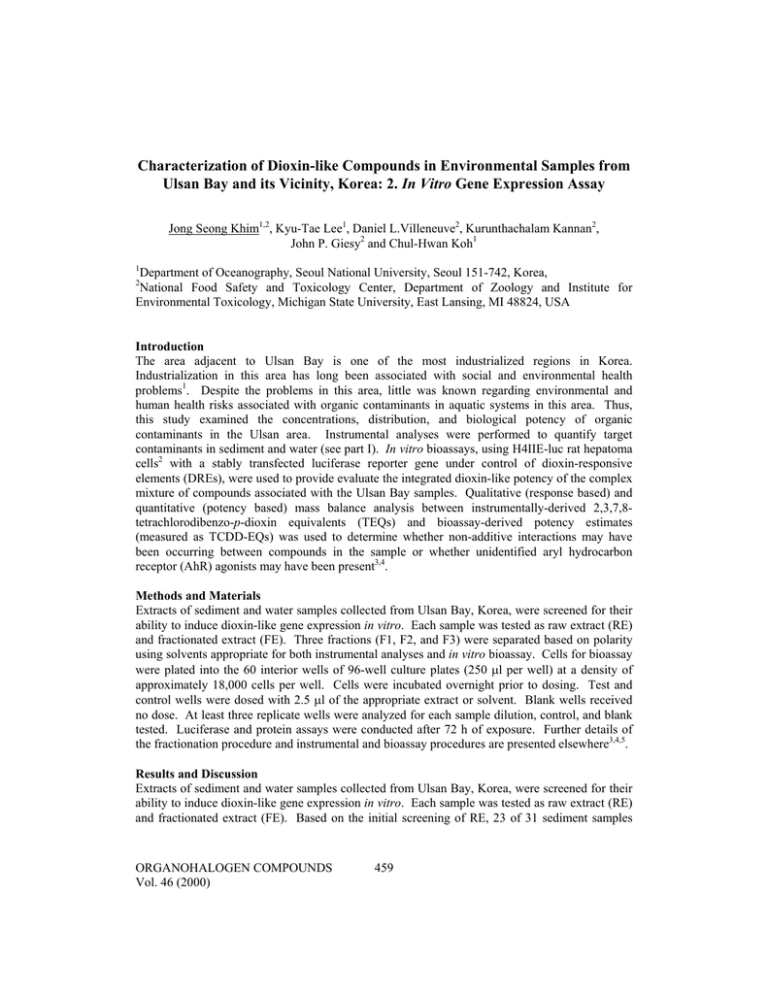
Characterization of Dioxin-like Compounds in Environmental Samples from Ulsan Bay and its Vicinity, Korea: 2. In Vitro Gene Expression Assay Jong Seong Khim1,2, Kyu-Tae Lee1, Daniel L.Villeneuve2, Kurunthachalam Kannan2, John P. Giesy2 and Chul-Hwan Koh1 1 Department of Oceanography, Seoul National University, Seoul 151-742, Korea, National Food Safety and Toxicology Center, Department of Zoology and Institute for Environmental Toxicology, Michigan State University, East Lansing, MI 48824, USA 2 Introduction The area adjacent to Ulsan Bay is one of the most industrialized regions in Korea. Industrialization in this area has long been associated with social and environmental health problems1. Despite the problems in this area, little was known regarding environmental and human health risks associated with organic contaminants in aquatic systems in this area. Thus, this study examined the concentrations, distribution, and biological potency of organic contaminants in the Ulsan area. Instrumental analyses were performed to quantify target contaminants in sediment and water (see part I). In vitro bioassays, using H4IIE-luc rat hepatoma cells2 with a stably transfected luciferase reporter gene under control of dioxin-responsive elements (DREs), were used to provide evaluate the integrated dioxin-like potency of the complex mixture of compounds associated with the Ulsan Bay samples. Qualitative (response based) and quantitative (potency based) mass balance analysis between instrumentally-derived 2,3,7,8tetrachlorodibenzo-p-dioxin equivalents (TEQs) and bioassay-derived potency estimates (measured as TCDD-EQs) was used to determine whether non-additive interactions may have been occurring between compounds in the sample or whether unidentified aryl hydrocarbon receptor (AhR) agonists may have been present3,4. Methods and Materials Extracts of sediment and water samples collected from Ulsan Bay, Korea, were screened for their ability to induce dioxin-like gene expression in vitro. Each sample was tested as raw extract (RE) and fractionated extract (FE). Three fractions (F1, F2, and F3) were separated based on polarity using solvents appropriate for both instrumental analyses and in vitro bioassay. Cells for bioassay were plated into the 60 interior wells of 96-well culture plates (250 μl per well) at a density of approximately 18,000 cells per well. Cells were incubated overnight prior to dosing. Test and control wells were dosed with 2.5 μl of the appropriate extract or solvent. Blank wells received no dose. At least three replicate wells were analyzed for each sample dilution, control, and blank tested. Luciferase and protein assays were conducted after 72 h of exposure. Further details of the fractionation procedure and instrumental and bioassay procedures are presented elsewhere3,4,5. Results and Discussion Extracts of sediment and water samples collected from Ulsan Bay, Korea, were screened for their ability to induce dioxin-like gene expression in vitro. Each sample was tested as raw extract (RE) and fractionated extract (FE). Based on the initial screening of RE, 23 of 31 sediment samples ORGANOHALOGEN COMPOUNDS Vol. 46 (2000) 459 showed significant dioxin-like activity in H4IIE-luc bioassay, where as, most water and pore water samples did not elicit response (Table1, Figure 1). Most of the activities associated with FE samples revealed that mid polar (F2) and most polar (F3) fractions were responsible for the significant reporter gene expression in H4IIE-luc bioassay (Figure 2). All F2 samples except for one induced significant dioxin-like activity. Ten of the F2 samples produced magnitudes of response in H4IIE-luc bioassay similar to those induced by a 2,3,7,8-tetrachlorodibenzo-p-dioxin (TCDD) standard. Sediment associated with F2 samples was estimated to contain approximately 0.01-0.83 ng TCDD-EQ/g dry wt. Based on a qualitative mass balance analysis, PAHs appeared to account for only a portion of dioxin-like responses observed. Again most F3 samples induced dioxin-like activity significantly. Over half F3 samples were either cytotoxic or caused morphological changes in H4IIE-luc cells, however. Known concentrations of alkylphenols and bisphenol A were not great enough to account for cytotoxicity observed in F3 samples (see part I). The great responses observed in F2 and F3 samples were not without precedent. Similar magnitudes of dioxin-like activity were elicited by F2 and F3 of sediment extracts from Lake Shihwa and Masan Bay, Korea 3,5. These observations add to a growing body of evidence which suggests that there may be unidentified, relatively polar, AhR-active compounds in sediment from some areas. Table 1. The Screening Result of H4IIE-luc in vitro Bioassay Cytotoxicity Sample No. of Tested Significant or Stressedb Type Samples Inductiona Sediment 31 31 23 9 Pore Water 17 17 0 0 18 17 7 0 Particulate Matter 16 16 0 0 Dissolved Phase a Significant induction means above the 3 standard deviations (expressed in %-TCDD-max.) of the mean solvent control response (set to 0%-TCDD-max.) b Indicates cells exhibited an altered or "stressed" morphology Acknowledgements This work was supported from National Institute of Environmental Research (NIER), Ministry of Environment, Korea (Sediment Organic Compounds Bioassay Study; SORGBIOS). The chemical and bioassay analyses were performed at MSU. We thank Jac Aarts, University of Wageningen, Netherlands and colleagues from the Benthos Lab at Seoul National University, Korea. References 1. Kang S.G., Choi M.S., Oh I.S., Wright D.A., and Koh C.H. (1999) Sci Total Environ 234:127-137. 2. Sanderson J.T., Aarts J.M.M.J.G., Brouwer A., Froese K.L., Denison M.S., and Giesy J.P. (1996) Toxicol Appl Pharmacol 137:316-325. 3. Khim J.S., Villeneuve D.L., Kannan K., Lee K.T., Snyder S.A., Koh C.H., and Giesy J.P. (1999) Environ Toxicol Chem 18:2424-2432 . 4. Khim J.S., Villeneuve D.L., Kannan K., Koh C.H., and Giesy J.P. (1999) Environ Sci Technol 33:4206-4211. 5. Khim J.S., Kannan K., Villeneuve D.L., Koh C.H., and Giesy J.P. (1999) Environ Sci Technol 33:4199-420. ORGANOHALOGEN COMPOUNDS Vol. 46 (2000) 460 40 35 Sediment 30 PW %-TCDD-Max. 25 20 15 10 5 0 T1 T2 T3 Y0 Y1 Y2 Y3 Y4 Y5 J0 J1 J2 U1 U2 U5 U7 T4 Y1 Y3 Y4 Y5 J0 J1 J2 U1 U5 U7 U16 -5 -10 40 35 DF %-TCDD-Max. 30 PM 25 20 15 10 5 0 T0 T1 T2 T3 -5 Location Figure 1. Luciferase induction in the H4IIE-luc cell bioassay (dioxin responsive) elicited by Ulsan Bay sediment, pore water, water sample extracts. Response magnitude presented as percentage of the maximum response observed for a 2000 pM 2,3,7,8 tetrachlorodibenzo-p-dioxin standard (%TCDD-max.). ORGANOHALOGEN COMPOUNDS Vol. 46 (2000) 461 120 RE F1 F2 F3 100 %-TCDD-Max. 80 60 40 20 0 Y0 Y1 Y2 Y3 Y4 Y5 J0 J1 J2 J3 J4 RE F1 F2 F3 U14 U15 U16 -20 100 %-TCDD-Max. 80 60 40 20 0 U1 U3 U4 U6 U7 U9 U13 PB -20 Location Figure 2. Luciferase induction in the H4IIE-luc cell bioassay (dioxin responsive) elicited by Ulsan Bay sediment extract (RE), fractions 1, 2, 3 (F1, F2, F3), and procedural blank (PB). Response magnitude presented as percentage of the maximum response observed for a 2000 pM 2,3,7,8 tetrachlorodibenzo-p-dioxin standard (%-TCDD-max.). ORGANOHALOGEN COMPOUNDS Vol. 46 (2000) 462
